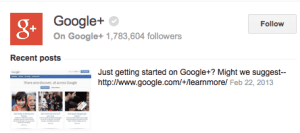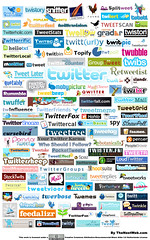By
By now your byline for any blog post, guest post, or other online published piece should be linked directly with a Google+ profile via Google Authorship. There is so much being written and shared about this topic, and it will not be a rehash here. What you will see are some very smart people sharing insights about Google Authorship that are too good to just let die in my Google+ stream. I’m going to share some thoughts for you in a random way from around the channels. I’d like your call to action to be to establish Google Authorship ASAP for your byline throughout the Interwebz.
About Google Authorship
Establish Google Authorship to claim brand, original content and rank.
This is to attempt to avoid what happened to of when his blog post was scraped. Because he had added a hyperlink to an archived post, he got a pingback from the culprit’s blog.
Having Google Authorship allows the original author to claim dibs on original content; however, according tothe acclaimed Google+ guru (he really is), there is nothing in place with Google + right now that protects any writer from content scraping.
“We need to be careful about overstating the claims of Authorship. In the introductory video Google’s Othar Hansson said that they could use authorship to determine the true author of content, not that they are (yet).
In any case, it doesn’t prevent someone from copying your content, just wouldn’t allow them to outrank you for it. I suspect we will have to wait for implementation of Author Rank for that to be fully in effect,” said Mark in a Google+ thread with Neal, , and me.
Frank Strong, who writes , is credited with alerting me to what’s been happening with recently on the topic.
Back to Neal’s story…when he got a ping back, he rang the alarm bells in his community, and due to the ruckus raised, the offender removed the post (bet they won’t do that again, eh, Neal?)
said in a recent G+ thread, ” I still recommend every blogger to at least include one internal link in each of their blog posts so that if their content does get copied, and it’s often copied as part of blogs automatically importing content through RSS feed manipulation, that at least you get a back link.”
What Google Authorship also does is help rank that author in search for original content all over the Interwebz. Can you say guest posting anyone? How about blogging communities? (Just so you know, is accepting new bloggers; it’s a blogging community I established in 2010 that is ebbing out of dormancy.)
How To Set Up Google Authorship on WordPress Blogs
If you need help setting up Google Authorship, please go directly to After examining four different blog posts sharing perspective on how to synch your WordPress-powered blog with Google Authorship, this one on Tizish by Josh Galvan was the easiest to understand in plain English. It also did not omit any steps like the others did (in re the back-end coding which is explained very well). My pal will attest to the ease with which this tutorial takes you through the steps.
Thanks for indulging my ping-pong sharing on this topic. When I learn so much in one Google+ stream, it’s too rich to toss by the wayside, and I wanted you to learn as I do, too.












 There has been so much bogus “
There has been so much bogus “




















